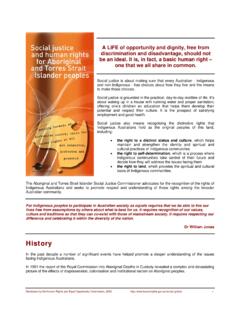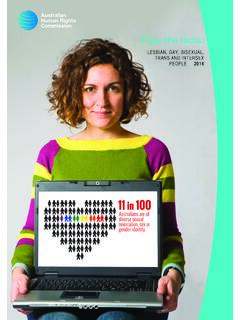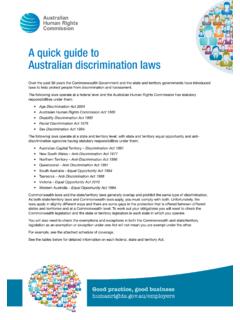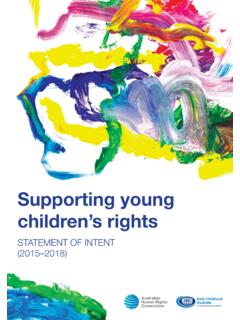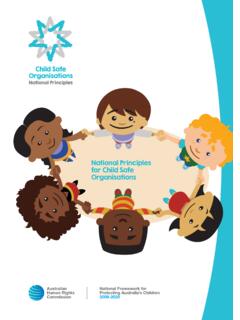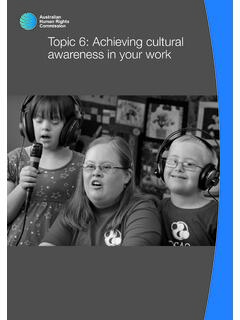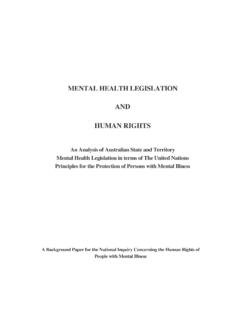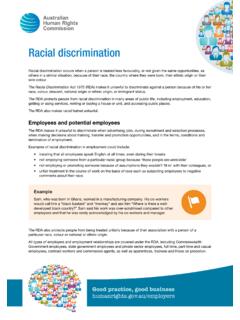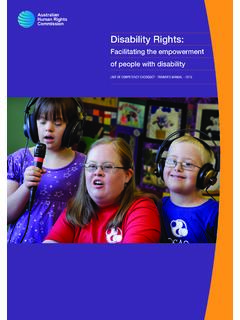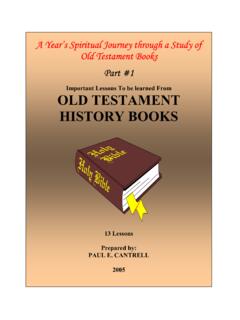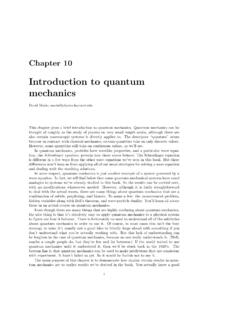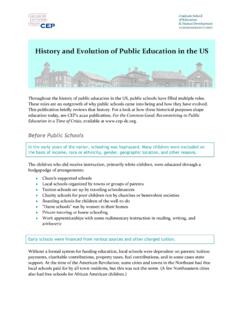Transcription of A long history of racism and sport
1 L IntroductionRacism and prejudice in Australian sportIs racism in sport an issue in Australia? After all, Australians of various colour, race and ethnic origin united as one to cheer home Cathy Freeman to gold in the final of the Sydney Olympic Games 400 metres. And in June 2006, an estimated million Australians got up between one and three in the morning to watch Australia play Italy in the second round of the FIFA World That translates as one in three men, women and children in the country watching a game formerly known as wogball and passionately barricking for a multicultural mix of players, with names such as Aloisi, Grella, Bresciano, Schwartzer and Viduka to name a week, team-mates and fans alike get out to support Indigenous players and those from culturally and linguistically diverse backgrounds in national, state and local sporting competitions be it league, union, netball, hockey, Australian football or basketball.
2 It would seem that sport and sporting events are the ultimate cross-cultural mixing pot in Australia; a place where respect for ability and the camaraderie of teamwork overcomes intolerance and exclusion, and where we cheer on our champions no matter what the colour of their skin or the sound of their surname. Or do we?Research suggests that while racist attitudes have remained strong in Australia over the last 10 years, there has been a considerable reduction in overt racist behaviour, due in part to the development of strong social norms against openly expressing racist views. Such a shift in attitudes is backed up by comprehensive racial discrimination laws administered by the Human Rights and Equal Opportunity Commission (HREOC) at a federal level, as well as state and territory anti discrimination commissions. However, the research also indicates that these social norms are not well developed in all areas of Australian life one such public forum where racism still rears its ugly head is the sporting long history of racism and sportRacism has been the ugly underbelly of Australian sport for over a century.
3 Take for example Eddie Gilbert; a Queensland fast bowler who took 5 for 65 against the touring West Indies in 1929 and who once bowled Sir Donald Bradman for a duck in 1931, who was excluded from higher honours because of his Indigenous Or Doug Nicholls, the champion Fitzroy Australian rules football winger, and later the Governor of South Australia, who was initially rejected by blue-blood Carlton in the late 1920s because he smelled .3 During the early years of Australia s federation to the dominant culture racist abuse was normal and legitimate; it was simply a part of playing the game. 4 Attitudes of racism and exclusion have persisted across sporting codes since those days. l What s the score? A survey of cultural diversity and racism in Australian sportRacial abuse between players on the field only attracted any real attention following the first ever formal complaint lodged by Essendon s Michael Long in 1995, and even this only became public following Long s dissatisfaction at the outcome of the hastily organised mediation.
4 As a result, in June 1995 the AFL implemented Rule 30: A Rule to Combat Racial and Religious Vilification . A decade later, these vilification rules have filtered down to junior, suburban and regional Australian football competitions in all states, and have been replicated by other sporting organisations and it is only in the last five to ten years that racism has been identified by a range of national sporting codes in Australia as being a significant issue. As a result, many individual codes have put in place a range of anti- racism strategies and initiatives to address the issue. Legal protectionsIn Australia, federal laws exist to protect people against racial discrimination in all areas of life, including sport . The Racial Discrimination Act 1975 (Cth) (RDA) (which is administered by HREOC) aims to ensure that people are treated equally, regardless of their race, colour, national and ethnic origin, descent, ethnic or ethno-religious Racial Hatred Act 1995 (Cth) extends the coverage of the RDA to allow people to make a complaint if they feel they have had racially offensive or abusive behaviour directed at them.
5 The RDA aims to strike a balance between the right to communicate freely and the right to live free from is also legislation in place in every state and territory making discrimination and harassment in relation to a person s race, colour, national and ethnic origin, descent, ethnic or ethno-religious background racial discrimination legislation a sporting organisation may also be held vicariously liable if people representing the organisation (such as coaches, board members, managers, officials, etc.) behave unlawfully in the course of their duties. The sporting organisation would need to show that they took all reasonable steps to prevent the unlawful act, ( establishing codes of conduct, policies and procedures, and providing education and training to their members) to avoid liability. 7 Racial discrimination legislation also defines certain harassing behaviours as offensive behaviours and as being unlawful.
6 Under the legislation, offensive behaviour is doing an act in public because of the race, colour or national or ethnic origin of a person or group of people that is reasonably likely to offend insult, humiliate another person or a group of vilification is defined as any act or form of behaviour that happens publicly which could incite others to hate, threaten, ridicule, insult or show contempt towards another person on the basis of that person s race, religion, colour, descent or national or ethnic origin. The nature of racism in sportRacism in sport is a complex problem. It can include: racism , discrimination, harassment or vilification by players directed at other players; by spectators directed at players; or racist behaviour among rival spectator groups which spill over into disruptions and violence in the stands. It also includes the actions of sporting officials and coaches, as well as media commentators.
7 introduction l In his book Aborigines in sport , Colin Tatz s observation that they re Australians when they re winning, and Aborigines at other times 8 sums up the public treatment of Aboriginal and Torres Strait Islander sportsmen and women over the last century. It has taken great courage for many Indigenous sportsmen and women to overcome racial prejudices in order to excel at their chosen sport . Their efforts have paved the way for change, albeit slow, as the sporting community shows a greater understanding of the issues confronting Aboriginal players. Further, their achievements have broken down barriers and made them role models for Indigenous and non-Indigenous people , racist attitudes and racist behaviour is just as likely to include an emphasis on culture as it is on colour , including religion, language, ethnicity and national origins. Recent incidents of racism and vilification might include a young Muslim woman being abused for wearing her headscarf during a junior soccer match, or an Iraqi refugee being harassed at a basketball still existsIn some quarters, there is a perception and portrayal that the battle against racism has been But just when its seems as though racial and religious vilification laws and anti-discrimination policies in our national sporting codes are working effectively, along comes another racial incident by one of our sportspeople or commentators to remind us that the issue remains very much alive.
8 If it s not former South Sydney NRL captain Bryan Fletcher giving the Indigenous Parramatta player Dean Widders a verbal racist spray in an NRL game in 2005, then it s Australian Rugby Union player Justin Harrison racially sledging his opposition s winger in a 2005 Super 12 game, or it s an Under 12 football coach allegedly screaming racist abuse at young Sudanese boys in a North Melbourne league. These incidents are not the summer of 2005 06, crowd racism reared its ugly head at the WACA ground in Perth as spectators hurled a range of racist insults at black members of the South African cricket team. This behaviour continued at the Melbourne, Brisbane and Sydney test matches. The visiting Sri Lankan team didn t escape this treatment either with a group of drunken fans hurling abuse at their fielders during a one day match with Australia in Adelaide. And again in 2005, ethnic-based violence at a Premier League soccer match between the Bonnyrigg White Eagles and Sydney United resulted in a near riot, with a group of 50 fans throwing flares and other projectiles at each t believe the spin doctors racism still exists in room for racistsWhile the issue of racism in sport is still prevelant, attitudes condoning racism have gone by the wayside.
9 The age old adage what happens on the field stays on the field is not sufficient justification anymore. Respected journalist and former international rugby union star Peter Fitzsimons, writing under the headline No room for racists in the Sydney Morning Herald in 10 l What s the score? A survey of cultural diversity and racism in Australian sport2005, raised concerns about three former international Indigenous rugby league players and their take on the Widders He wrote: Another line of defence has come from former league stars such as Colin Scott, Sam Backo and Tony Currie, who said that when they were playing they, too, were sledged for their Aboriginality, and yet their view was that they were happy to leave it on the , with respect, it s not just about you. The point of nailing those who utter such sledges is not just to ensure that Aboriginal players are protected from racist nastiness it is to make sure that all Australians understand they are in a culture where this is no longer acceptable.
10 11 Fitzsimons last line sums it up it is to make sure that all Australians understand they are in a culture where this is no longer acceptable . That s it. Full stop. End of Widders illustrated the point in another way. He said: I remember being at a function where two players who had played in the same team for over 10 years were part of a general discussion. The non-Aboriginal player turned to the Aboriginal player and said: ..it s like when I used to call you a black so and so. You knew it was a joke . The Aboriginal player, who has accepted this for years, finally had the courage to say No, I didn t . They were friends, but that night was the first step in them reaching a better understanding of each other. All Australians from all backgrounds need to get to know each other better. Making a stand against racial comments is only one step in the process. 12 sport as a cultural and racial bridge-builderAcademic, Lawrence McNamara, states that racist abuse is of special relevance because it concerns not only issues of participation but also speaks to broader attempts to combat racism and racial hatred in the wider community when sport becomes a forum for debate and even, at times, a model for change and progress.
